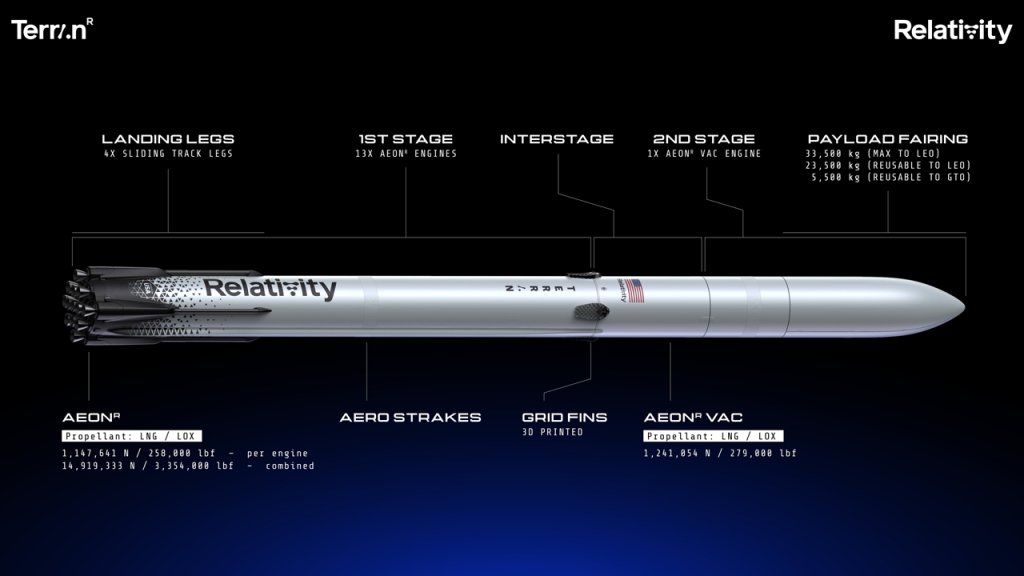
Relativity Space Dumps Terran 1 in Favor of Larger Terran R (Image Credit: Payload)

Relativity Space has announced that it was ending development of the Terran 1 rocket that failed during its maiden flight last month in favor of developing its larger Terran R launch vehicle.
The Terran R rocket that Relativity Space unveiled would be more powerful than the previous version of the booster. The updated design is only partially reusable instead of the fully reusable original version. Flights from Florida are due to begin in 2026.
Comparison of Terran 1, Terran R & Falcon 9
| Terran 1 | Terran R | Falcon 9 | |
|---|---|---|---|
| Stages | 2 | 2 | 2 |
| Height | 35.2 m (115.5 ft) | 82.3 m (270 ft) | 70 m (229.7 ft) |
| Diameter | 2.3 m (7.5 ft) | 5.5 m (18 ft) | 3.7 m (12.1 ft) |
| First Stage Engines | 9 Aeon 1 | 13 Aeon R | 9 Merlin 1D+ |
| Second Stage Engine | 1 Aeon Vac | 2 Aeon Vac | 1 Merlin 1D Vacuum |
| Propellants | Methane – Liquid Oxygen | Methane – Liquid Oxygen | RP-1 – liquid oxygen |
| Payload to LEO (Reusable) | — | 23,500 kg (51,809 lb) |
17,400 kg (38,360 lb) |
| Payload to LEO (Expendable) | 1,479 kg (3,261 lb) |
33,500 kg (73,855 lb) |
22,800 kg (50,265 lb) |
| Payload to GTO (Reusable) | — | 5,500 kg (12,125 lb) |
5,500 kg (12,125 lb) |
| Payload to GTO (Expendable) | — | — | 8,300 kg (18,300 lb) |
Terran R will be able to deliver 23,500 kg (51,809 lb) to low Earth orbit in its reusable version or 33,500 kg (73,855 lb) in its expendable variant. A reusable Terran R fitted with landing legs will be capable of delivering 5,500 (12,125 lb) to geostationary transfer orbit.
Terran R’s first stage will have 13 3D-printed Aeon R engines powered by methane and liquid oxygen each capable of 258,000 lb of thrust at sea level. The second stage will have a single Aeon Vac engine with 279,000 lb of thrust in vacuum.
“Initially, Terran R will use the same proprietary printed aluminum alloy as flown on Terran 1 with a focus on supply chain scaling. However, a third-generation aluminum alloy, designed for improved performance of an orbital vehicle mission life beyond 20 reusable flights, is in active development, which is accelerated by the aid of artificial intelligence-based alloy discovery tools,” the company said in a press release.
CEO and Co-founder Tim Ellis compared Terran 1 to “a concept car” that allowed the company to build a launch vehicle that was about 85% manufactured using 3D printing.
“Our first chapter as a company was to prove to the world 3D printed rockets were viable. We just did that with Terran 1. Our second chapter is to build the next great launch company with Terran R,” Ellis said. “Terran R is the most customer-centric next generation launch vehicle. It is not a conventional rocket. This is a new breed of launch vehicle with the right payload performance, reliability, focus on speed of development, optimized reusability, focus on scalability of launch ramp rate, and ultimately cost reduction baked into the architecture design and our program plans from day one.”
Relativity said it plans to build a new launch pad for Terran R adjacent to the existing Terra 1 facilities at Space Launch Complex 16 at the Cape Canaveral Space Force Station in Florida. Launch vehicles will be produced in Long Beach, California, and shipped to Florida via the Panama Canal.
“The entire Iridium team congratulates Relativity on a historic first launch, proving the viability of 3D printed rockets. As Iridium knows, being successful in space takes hard work, innovation and perseverance. We applaud their transition now to completing Terran R, which is better aligned with industry’s anticipated future launch requirements. We look forward to seeing Relativity’s continued success and the new possibilities they are bringing to the industry as a whole,” said Iridium CEO Matt Desch.
Relativity said it has a backlog of $1.65 billion in launch agreements with seven customers.

Terran 1’s first stage performed as designed after launch from the Cape Canaveral Space Force Station in Florida on March 22, 2023. However, the second-stage engine failed to fire after separation from the first stage, dooming the flight. The booster did not carry a payload.
In an update, Relativity said the main valves on the second stage engine opened slower than planned. The anomaly negatively affected the pressures in the engine and the timing of the propellant reaching the thrust chamber and gas generator.
The engine’s fuel pump generated pressure but the oxygen pump failed to do so, which also negatively affect propellant timing. Relativity said data indicates that a vapor bubble was present at the oxygen pump’s inlet.
As a result, the gas generator failed to light, resulting in the engine failing to reach full power.




